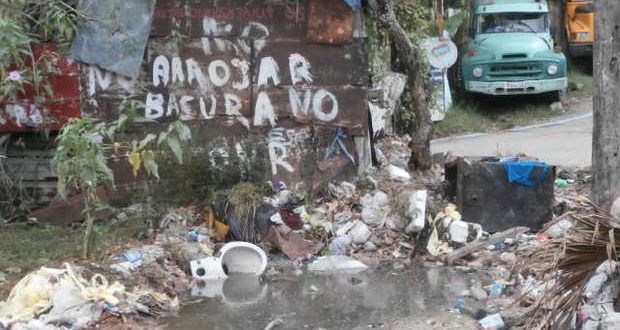
Ivan Garcia, 27 October 2016 — The state aqueduct brigade came to La Vitoria neighborhood on Friday morning and using sledgehammers destroyed the sidewalks to install water meters on every home.
The October rains transformed the open ditches into quagmires. Many of the connections were gushing water. Six days later, after the complaints and phone calls from the residents, another brigade arrived from the capital city’s Water and Sewer Company in a rickety truck from the Soviet era, to repair the leaks and fill in the ditches.
The work was bungled. The cement patches on the sidewalks caved in and some of the water meters continued to leak. Leaks of sewage water and drinking water are nothing new in Cuba.
According to reports from the official press, half the drinking water in Havana is lost through leaks in the pipes. Some 50% of the water and sanitation networks in the city are in fair or poor condition.
State media broadcasts commercials targeting the population, urging people to repair the own leaks. But a simple faucet costs a third of a worker’s monthly salary.
Fermín, an official from the Housing Institute, recognizes that between 40 and 60 percent of the multifamily buildings in Havana have problems in their water and sewer lines.
“From leaks to poor installation in the waste networks. For lack of maintenance, the majority of pipes have leaks. Many of the pumps [which pump the water up to tanks on the roofs] are old and are big users of electricity. The tanks of almost all the buildings in Havana haven’t been cleaned for years, which can cause outbreaks of illnesses. The repairs are on the residents. The state, for lack of money, doesn’t repair the city’s buildings,” says Fermín.
The infrastructure of the Cuban capital is lamentable. The trash collection services are insufficient and people throw out their garbage and even broken toilets on any corner. In the streets where tourists don’t generally walk cleaning is conspicuous by its absence.
Only the electricity networks have been repaired, so there is less loss of electricity and the voltage has improved. The same can’t be said about the telephone lines.
“When ETECSA [the state phone company] was a joint venture business with Italian capital repairs were routinely programmed. But now that the Army owns it, it’s painful to observe the working conditions of our technicians. They have to work tying together old wires and many of them are screaming for repairs to be done,” says Delia, an ETECSA engineer.
On a scale of one to ten, the assessment of public transport is a zero. Getting from one place in the city to another can take two or three hours.
In Havana there is a network of articulated buses designated with the letter P. There are 16 routes that, in theory, run every five to ten minutes during rush hour. But most of the time they don’t run any more often than every fifteen minutes and often it’s every hour. The six existing terminals should have a fleet of 540 buses.
“The ideal is that every one of the 16 routes would have 30 buses. But the terminals are outdated or incomplete. There are terminals like Calvario or Alamar, with three routes each and only 35 buses,” says a drive on the P-6 route.
Also planned was a network of buses circulating through the neighborhoods and secondary streets of the city. But there is also a deficit there. That’s the case with the routes 15 and 67, and now people don’t even wait for them, as it’s usually three or more hours between buses.
Taxi service in Cuban pesos is a calamity. In the ’80s Havana had a fleet of almost 3,000 taxies. Today there are fewer than 200. They have to serve the taxi stands at the hospitals, funeral homes and train terminals. Then, when they meet their quota, they run illegally and are more expensive than the private taxis.
There is a fleet of taxis in hard currency, but they are too expensive for most people on the island. They run modern air-conditioned cars. And the prices are at the discretion of the driver.
For three years the hard currency cars were rented to the drivers by the state. According to Manuel, “even though now I can earn 200 Cuban convertible pesos (roughly $200) a month, we have to work like slaves for fourteen hours a day to pay the fee imposed by the government, 55 convertible pesos a day. That’s why you don’t see any of the taxis using the meter. The people are greatly affected. If, before, the ride from Vedado to La Vibora was 5 CUC, now it’s 10 or 15 CUC.”
The regime turned its heavy guns on the private taxi drivers, capping prices and threatening them with big fines or the confiscation of their licenses for any who violate the state decrees.
But the official media keeps its mouth shut when it’s time to criticize the prohibitive prices of the hard currency taxis. If getting around the city is a nightmare, having to deal with the bureaucratic red tape is worse.
In Cuba, for anything you want to do there is always the bureaucratic red tape. Since a change in direction, getting a passport or paying a phone bill. The lines are hours-long and the officials, with their crabbed faces, treat us like we’re criminals.
Despite a fourth-world infrastructure, some absent-minded Swiss named Havana a “2016 Wonder City.” Of course its promoter lives in Switzerland.
Translated by Jim
